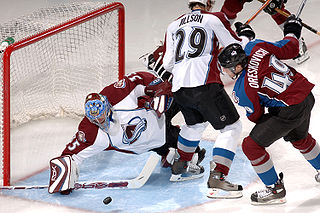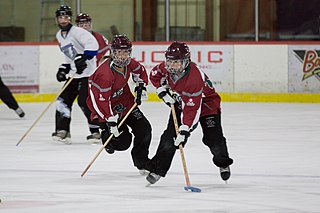
Lacrosse is a contact team sport played with a lacrosse stick and a lacrosse ball. It is the oldest organized sport in North America, with its origins with the indigenous people of North America as early as the 12th century. The game was extensively modified by European colonists, reducing the violence, to create its current collegiate and professional form.

In many team sports that involve scoring goals, the goalkeeper is a designated player charged with directly preventing the opposing team from scoring by blocking or intercepting opposing shots on goal. Such positions exist in bandy, rink bandy, camogie, association football, Gaelic football, international rules football, floorball, handball, hurling, field hockey, ice hockey, roller hockey, lacrosse, ringette, rinkball, water polo, and shinty, as well as in other sports.

Box lacrosse, also known as boxla, box, or indoor lacrosse, is an indoor version of lacrosse played mostly in North America. The game originated in the 1930s in Canada, where it is more popular than field lacrosse. Lacrosse is Canada's official national summer sport. Box lacrosse is played between two teams of five players and one goalie each, and is traditionally played on an ice hockey rink once the ice has been removed or covered. The playing area is called a box, in contrast to the open playing field of field lacrosse. The object of the game is to use a lacrosse stick to catch, carry, and pass the ball in an effort to score by shooting a solid rubber lacrosse ball into the opponent's goal. The highest level of box lacrosse is the National Lacrosse League.

In ice hockey, the goaltender is the player responsible for preventing the hockey puck from entering their team's net, thus preventing the opposing team from scoring. The goaltender mostly plays in or near the area in front of the net called the goal crease. Goaltenders tend to stay at or beyond the top of the crease to cut down on the angle of shots. In the modern age of goaltending there are two common styles, butterfly and hybrid. Because of the power of shots, the goaltender wears special equipment to protect the body from direct impact.

A goaltender mask, commonly referred to as a goalie mask, is a mask worn by goaltenders in a variety of sports to protect the head and face from injury from the ball or puck, as they constantly face incoming shots on goal. Some sports requiring their use include ice hockey, lacrosse, inline hockey, field hockey, rink hockey, ringette, bandy, rinkball, broomball, and floorball. This article deals chiefly with the goal masks used in ice hockey.

Clinton Stevenson "Praying Benny" Benedict was a Canadian professional lacrosse goalie, ice hockey goaltender who played for the Ottawa Senators and the Montreal Maroons. He played on four Stanley Cup-winning squads. He was the first goaltender in the National Hockey League (NHL) to wear a face mask. He led league goaltenders in shutouts seven times over his professional career. He is a member of the Hockey Hall of Fame.

In ice hockey, the goaltender wears specialized goaltending equipment to protect themselves from the impact of the puck, and to assist in making saves. Ringette and rinkball goaltenders use the same equipment with some exceptions. This article deals chiefly with the sport of ice hockey.

The five-hole is an ice hockey term for the space between a goaltender's legs. The name and its first recorded usage was in 1976 by Flyer Reggie Leach The phrases through the five-hole and gone five-hole are used when a player scores by shooting the puck into the goal between the goaltender's legs. The term is also used in basketball, association football, field hockey, and lacrosse. In baseball, the term is used to describe a wild pitch between the catcher's legs.
Douglas Robert Favell is a Canadian former professional ice hockey goaltender and former box lacrosse player. Favell played in the National Hockey League for the Philadelphia Flyers, Toronto Maple Leafs and Colorado Rockies.

Ringette is a non-contact winter team sport played on an ice rink using ice hockey skates, straight sticks with drag-tips, and a blue, rubber, pneumatic ring designed for use on ice surfaces. While the sport was originally created exclusively for female competitors, it has expanded to now include participants of all gender identities. Although ringette looks ice hockey-like and is played on ice hockey rinks, the sport has its own lines and markings, and its offensive and defensive play bear a closer resemblance to lacrosse or basketball.

Ball hockey is a team sport and an off-ice variant of the sport of ice hockey. The sport is also a variant of one of several floor hockey game codes; more specifically, it is a variant of street hockey.

In ice hockey, players use specialized equipment both to facilitate the play of the game and for protection as this is a sport where injuries are common, therefore, all players are encouraged to protect their bodies from bruises and severe fractures.

Lacrosse gloves are heavily padded, protective gloves worn by men's lacrosse players. The gloves are designed to protect players' hands, wrists, and forearms from checks, or legal defensive hitting common in the sport. Gloves consist of thick padding on the back of the hand and forearm covered in leather or canvas material, and a palm area made of synthetic and mesh material. A goaltender's gloves may have extra padding for the thumb to protect against injury from shots. While NCAA collegiate rules require that men's gloves have palms covered, other leagues, including post-collegiate club lacrosse, the National Lacrosse League, Major League Lacrosse, and international play, permit players to cut out the palm area for greater grip and control of the lacrosse stick.

In ice hockey and association football, a goaltender is credited with a save when they prevent a shot by the opponent from entering the net. A goaltender's efficiency in stopping shots, the save percentage, is calculated as a percentage of shots stopped divided by the total number of shots on goal. If a goaltender makes all the saves within a game it is called a shutout. In association football this is called a clean sheet.

The goalie blocker is a rectangular piece of equipment worn by goaltenders in the sports of ice hockey, roller hockey, rink hockey, broomball, and ringette. It is generally worn on the dominant hand. This article deals chiefly with blockers worn by goalies who play winter sports.

In field lacrosse, the goaltender is the most important and last line of defense between the opposing offense and the goal. The goaltender's primary roles are to defend the opposing team's shots on goal and to direct the defense.

Pads are a type of protective equipment used in a number of sports and serve to protect the legs from the impact of a hard ball, puck, or other object of play travelling at high speed which could otherwise cause injuries to the lower legs. These are used by batters in the sport of cricket, catchers in the sports of baseball and fastpitch softball, and by goaltenders in sports such as ice hockey, ringette, bandy, rinkball, field hockey, rink hockey and box lacrosse.

The sport of lacrosse has been played in the United States by Native Americans long before European exploration. The sport is most popular in the northeast and mid-Atlantic areas of the country. However, the game has recently developed into a popular team sport for both men and women in all regions of the United States.
Nick Rose is a Canadian professional box lacrosse goaltender currently playing for the Toronto Rock of the National Lacrosse League (NLL). He is also the current president and general manager of the Orangeville Northmen of the Ontario Junior Lacrosse League (OJLL). Originally drafted 28th overall by the Rock in the 2008 NLL Entry Draft, he spent time with the Boston Blazers and Calgary Roughnecks before returning to Toronto in 2012.


























